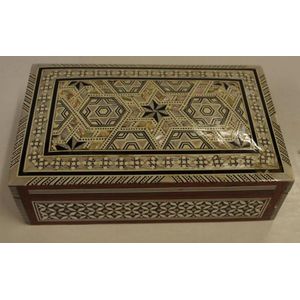Edwardian Silver Cigarette Case with Picture Compartment
An Edward VII silver cigarette case by Charles S Green & Co Ltd, Birmingham 1905 of plain form, hinged frontal panel opens to reveal a picture compartment. gilded interior, engraved shield with fleur-de-lis detail, initials Df, weight 103.1gms, length 8 cm, width 6 cm
You must be a subscriber, and be logged in to view price and dealer details.
Subscribe Now to view actual auction price for this item
When you subscribe, you have the option of setting the currency in which to display prices to $Au, $US, $NZ or Stg.
This item has been sold, and the description, image and price are for reference purposes only.
- Fleur-De-Lis - The fleur-de-lis is a stylized lily or iris flower with
three petals that has been used as a decorative motif for thousands of years. It
often appears in Christian iconography symbolising the Holy Trinity and as an
emblem that reflects the purity of the Virgin Mary. In decorative art and antiques
decoration, the fleur-de-lis is often used as a symbol of elegance, refinement,
and good taste.
The fleur-de-lis has a rich history and in ancient times, it
was associated with royalty, purity, and the divine, and it was used as a
symbol of the French monarchy for many centuries.
It is a common design element in ceramics, silverware, jewellery,
furniture, and other decorative objects, and it can be found in many different
styles and forms. - Gilding - Gilding is a method of ornamentation whereby a thin sheet of gold metal is applied to items made of wood, leather, ceramics, glass and silver for decorative purposes.
For furniture including mirrors, the sheet of gold is usually applied over a coating of gesso. Gesso is a mixture of plaster of Paris and gypsum mixed with water and then applied to the carved wooden frames of mirrors and picture frames as a base for applying the gold leaf. After numerous coats of gesso have been applied, allowed to dry and then sanded a coat of "bole", a usually red coloured mixture of clay and glue is brushed on and allowed to dry, after which the gold leaf is applied. Over time parts of the gilding will rub off so the base colour can be seen. In water gilding, this was generally a blue colour, while in oil gilding, the under layer was often yellow. In Victorian times, gilders frequently used red as a pigment beneath the gold leaf.
Metal was often gilded by a process known as fire gilding. Gold mixed with mercury was applied and heated, causing the mercury to evaporate, the long-term effect of which was to kill or disable the craftsman or woman from mercury poisoning. The pursuit of beauty has claimed many victims, not the least of which were the artists who made those pieces so highly sought after today. - Edward Vii - Edward VII (1841 ? 1910) was King of the United Kingdom and the British Dominions and Emperor of India from 1901 until his death in 1910. He was the first British monarch of the House of Saxe-Coburg and Gotha, which was renamed the House of Windsor by his son, George V.
This item has been included into following indexes:
Visually similar items

A 15ct gold hard stone signet ring, set with an intaglio bloodstone depicting horses head, size O, 4.4g.
Sold by
in
for
You can display prices in $Au, $US, $NZ or Stg.

A Lucanian red-figure bell krater, 400-300 BC, decorated with Dianna seated and various attendants, 36 cm high, 35 cm across the handles
Sold by
in
for
You can display prices in $Au, $US, $NZ or Stg.

9ct gold double curb link chain, marked 9k Approx 14 grams, 47 cm Length
Sold by
in
for
You can display prices in $Au, $US, $NZ or Stg.

Ornately inlaid box 12 x 20 cm
Sold by
in
for
You can display prices in $Au, $US, $NZ or Stg.
